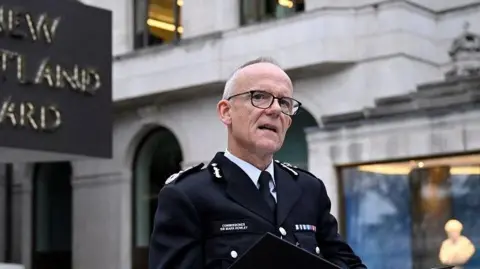The critical demand for enhanced funding within the policing sector has been underlined by Sir Mark Rowley, the Commissioner of the Metropolitan Police. In a recent editorial published in the Times, Rowley addressed the pressing need for additional resources to meet the government’s pledges on crime reduction. He emphasized that the government’s commitments cannot be fulfilled without a significant financial boost during the upcoming spending review scheduled for June.
Over the past decade, the police forces, particularly in England and Wales, have faced a prolonged period of underinvestment, which has severely affected their operational capabilities. Rowley pointed to a combination of mounting pressures, from increasing crime rates to rising social tensions—exemplified by crises such as last summer’s riots. These factors, he indicated, make the necessity of new funding not just important, but crucial for maintaining public safety and effectiveness in law enforcement.
Adding his voice to this urgent appeal, Rowley expressed serious concerns regarding potential cuts that could occur without comprehensive government support. He referred to what he termed “eye-watering choices,” reflecting the difficult decisions police forces would have to make. His statement made clear that police departments are currently operating under strained conditions, grappling with debt, dilapidated infrastructure, and obsolete technology—all while demanded to respond to higher rates of crime and social unrest.
In Rowley’s opinion, without an influx of funds, critical aspects of neighborhood policing would remain compromised, jeopardizing key government initiatives aimed at reducing knife crime and protecting women and girls from violence. He articulated that the forthcoming police funding settlement will play a significant role in determining if law enforcement can honor these governmental promises.
The government, through the Home Office, maintains that it is committed to backing police forces, asserting that funding has seen an overall increase this year. A spokesperson for the Home Office stated that up to £17.6 billion is allocated for police services, reflecting an increase of £1.2 billion. This funding is poised to create additional 13,000 neighborhood police officers, community support officers, and special constables to enhance public safety. However, the effectiveness and execution of these plans remain contingent upon the forthcoming spending review.
Chancellor Rachel Reeves is set to announce the details of this funding on June 11, outlining the blueprint for the government’s public service finances over several years. This review will establish the long-term economic framework influencing how policing is financed. Traditionally, police funding is chiefly determined through annual allocations decided by the House of Commons.
Adding to the urgency of the situation, local police departments have already expressed concerns over their ability to maintain current staffing levels given historical funding constraints. For instance, previously announced plans by Lincolnshire Police to cancel new officer intakes and Essex Police’s proposal to lay off community support officers highlight the precarious situation in which some forces find themselves. However, these decisions were revisited after receiving assurances of financial help from the government.
Community policing strategies have also been outlined by the government with an aim to boost patrols in areas identified as crime hotspots, especially during peak times, such as weekends. Plans to appoint an anti-social behavior lead in every police force aiming to develop local action plans underscore the government’s commitment to reducing community crime.
The overarching goal remains firm: to significantly reduce instances of knife crime and violence against vulnerable groups, such as women and girls, which have been prioritized in governmental discourse leading up to the review. As the repercussions of the upcoming funding decisions loom, Sir Mark Rowley’s emphatic call for financial support illustrates the intense pressure facing law enforcement agencies in maintaining public trust and safety amid rising societal challenges.



